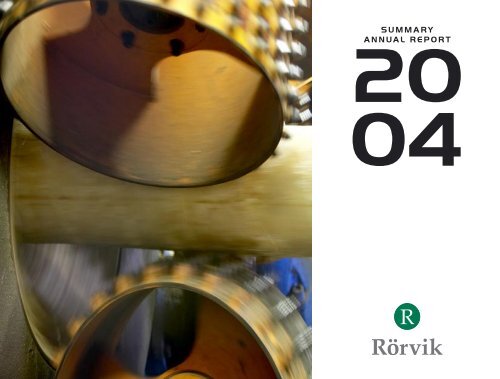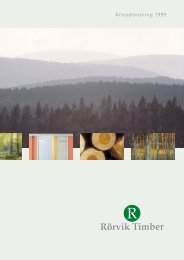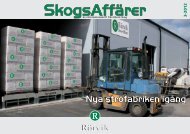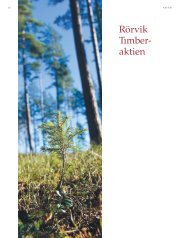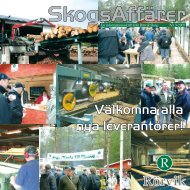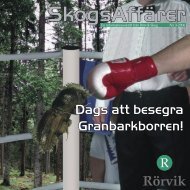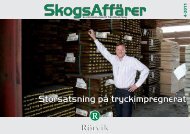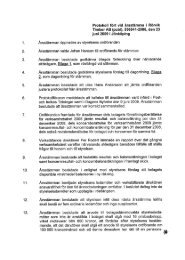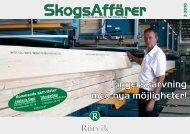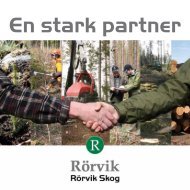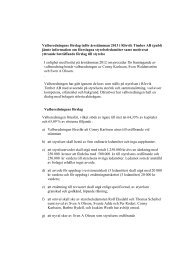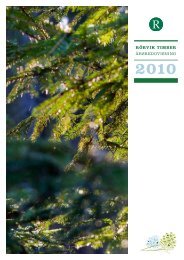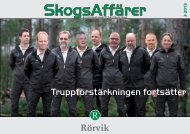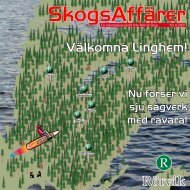Annual Report 2004 (pdf, 2.1 MB) - Rörvik Timber
Annual Report 2004 (pdf, 2.1 MB) - Rörvik Timber
Annual Report 2004 (pdf, 2.1 MB) - Rörvik Timber
Create successful ePaper yourself
Turn your PDF publications into a flip-book with our unique Google optimized e-Paper software.
S U M M A RY<br />
A N N UA L R E P O R T<br />
20<br />
04
CONTENTS<br />
The year in brief 3<br />
Managing Director’s comments 4<br />
<strong>Rörvik</strong> in brief 6<br />
Overview of recent years 8<br />
Business concept, goals and strategy 10<br />
<strong>Timber</strong> architecture 12<br />
The market 14<br />
Production 18<br />
Selling timber 21<br />
Investments 22<br />
Statement of income 24<br />
Cash flow analyses 25<br />
Balance sheet 26<br />
Changes in stockholders equity 27
THE YEAR IN BRIEF 3<br />
THE YEAR IN BRIEF<br />
• Net turnover increased to 1,388 MSEK (1.278)<br />
• Result after tax decreased to 1 MSEK (7)<br />
• Result per share was 0.07 SEK (0.55)<br />
• Operating income decreased to 14 MSEK (27)<br />
• Operating income for the <strong>Timber</strong> Business Area<br />
dropped to 12 MSEK (40)<br />
• Income for the fourth quarter of the year<br />
decreased considerably to –8 MSEK (8)<br />
The cost levels for timber raw material have<br />
increased<br />
The prices of timber product have been under<br />
considerable pressure<br />
• Operating income for the Wood Products<br />
Business Area increased to 10 MSEK (–3). Lower<br />
material costs of timber goods and reduced<br />
transport costs<br />
• Altered raw material conditions after the storm<br />
in January 2005<br />
<strong>2004</strong> 2003<br />
Net turnover, MSEK 1,388 1,278<br />
Operating income, MSEK 14 27.6<br />
Operating margin, % 1.0 2.2<br />
Income after finacial items 0 11.6<br />
Return on operating capital, % 2,4 5.0<br />
Return on stockholder equity, % 0.5 3.8<br />
Solidity, % 27.0 26.2<br />
Average number of employees 439 451<br />
Income per share, SEK 0.07 0.55
4<br />
MANAGING DIRECTOR’S COMMENTS<br />
AN INCREASE IN FOCUS<br />
Investments have been<br />
implemented according to<br />
plan. Going into 2005 all<br />
the pre-conditions for an<br />
industrially and financially<br />
strong <strong>Rörvik</strong> <strong>Timber</strong> are in<br />
place, says Johan Hansen,<br />
Managing Director and<br />
CEO of <strong>Rörvik</strong> <strong>Timber</strong>.<br />
OPERATIONS TO STRENGTHEN <strong>Rörvik</strong> <strong>Timber</strong> have<br />
continued during the year. The programme of investments<br />
for increased efficiency, that was decided upon<br />
in 2002, has been implemented according to plan. The<br />
year’s investments reached a level of 52 million SEK.<br />
In addition, there has been an increased focus on<br />
organisational changes, with the aim of coordinating<br />
and making better use of the group’s resources.<br />
Operations for change have been run on an increasingly<br />
tougher market. Sawmills are being squeezed<br />
between increasing raw material costs and falling<br />
sales prices.<br />
This was particularly evident towards the end of <strong>2004</strong>.<br />
THE MARKET<br />
The demand for sawn timber is good, though has<br />
weakened somewhat during the year. It has been<br />
particularly difficult for pine products. Prices have<br />
fallen. The market has been stable for spruce products.<br />
All in all, delivered prices were approximately 2<br />
percent lower compared with 2003. The produced<br />
sawn volume of timber has increased by 3 percent to<br />
531 tm 3 .<br />
The group’s operations within the pressure<br />
impregnated timber Business Area, have developed<br />
in a positive direction. The position that the largest<br />
players in the Nordic countries find themselves in<br />
has provided improved market potential for pine<br />
products. For the Wood Products Business Area the<br />
changes in organisation, in the form of outsourcing<br />
of production have entailed an increased focus on<br />
marketing and logistics. Refining to a pure “Trading<br />
House” has rapidly had the desired effects. Demand<br />
has been good and both volumes and margins have<br />
been able to be increased. The production units<br />
within the Business Area, Burseryds Listfabrik and<br />
BJU in Rottne have both shown positive sales and<br />
production developments.<br />
RAW MATERIALS<br />
Continued hard competition for raw material has prevailed,<br />
resulting in an increase in costs. The increased<br />
production volume within the sawmill industry has<br />
made it necessary to import a considerable amount<br />
of raw material. <strong>Timber</strong> costs have increased by 5<br />
percent compared with 2003. During the year, the<br />
group’s raw material organisation has been collected<br />
into a single, new unit, <strong>Rörvik</strong> Forest. The aim of this<br />
has been to achieve greater efficiency and improved<br />
processing of the raw material market by means of<br />
unified and common action. Raw material supplies<br />
have functioned well. Increased requirements have<br />
been able to be satisfied. A new raw material strategy<br />
has been implemented that will mean that, in<br />
the future, acquisitions will considerably exceed the<br />
needs of our own plants. The reason for this is to<br />
ensure that sufficient raw material is available, no<br />
matter the state of the market and to hold down<br />
raw material costs. As a first step in this strategy,<br />
major import agreements have been signed with<br />
Russian suppliers. In addition an agreement has been<br />
reached for the acquisition of raw material company<br />
Wijkström <strong>Timber</strong> AB which will be finalised at<br />
the beginning of 2005. By means of these measures<br />
<strong>Rörvik</strong> <strong>Timber</strong> will, from 2005 onwards, have control<br />
over a timber flow, the equivalent of more than<br />
2 million m 3 to. Those volumes that are not used by<br />
our own industries will be sold to industries within<br />
Sweden and on the continent.<br />
ANNUAL RESULTS<br />
Income after financial items decreased from 11.6 million<br />
SEK in 2003 to 0.2 million SEK. The background<br />
to this reduced income is the deteriorating margins<br />
for the <strong>Timber</strong> Business Area. Rising raw material<br />
prices and lower sales prices have meant that operational<br />
income decreased by 25.3 million SEK.<br />
For the Wood products Business Area, a good market<br />
and the effects of the programme of measures taken,<br />
has meant that the operational income has improved<br />
by 13.5 million SEK.
MANAGING DIRECTOR’S COMMENTS 5<br />
THE INVESTMENT PROGRAMME<br />
Despite a toughening market the investment programme<br />
has been implemented according to plan.<br />
Investments in plant reached 52 million SEK (63), of<br />
which 32 million SEK (9).has been financed via leasing<br />
agreements.<br />
The largest project has been carried out at the plant<br />
in Myresjö, where a new planing shop and a new<br />
timber reception facility are now in operation, with<br />
good results.<br />
The investments planned for 2005 will be directed<br />
towards increasing volumes. This will improve<br />
efficiency and reduce manufacturing costs.<br />
THE EFFECTS OF HURRICANE “GUDRUN”<br />
On the 8th January 2005 widespread storm damage<br />
was suffered in forests and other property, primarily<br />
in southern Halland and western Småland, in the<br />
south of Sweden. The group’s plants suffered only<br />
minor damage. Electrical power cuts caused a few<br />
days stoppage in production at two of the plants. In<br />
the short-term, the availability of timber for sawmills<br />
and other forestry products will considerably exceed<br />
the requirements of local industries despite the fact<br />
that felling and transport capacity is somewhat<br />
limited.<br />
Different methods for preserving timber blown<br />
down by the hurricane, either felled or still on the<br />
forest floor, for a shorter or longer period of time<br />
will be put into large scale operation by a number of<br />
different parties involved. Storage damage will occur<br />
to differing degrees in time and space. Agreements<br />
and statements made point towards the price level<br />
of storm-felled timber being clearly lower than what<br />
applied to sawmill timber in the autumn of <strong>2004</strong>.<br />
On the other hand, there will be increased costs<br />
for timber transport and storage as well as quality<br />
related costs throughout the whole of the processing<br />
chain, in order to limit the effects for the timber<br />
users and for the timber goods market as a whole.<br />
Extended periods of credit for the raw material<br />
extracted from the storm affected forest will have a<br />
positive effect on tied up capital. The cash flow effect<br />
for 2005 is deemed to be positive, but the exact level,<br />
at this point in time, is impossible to calculate.<br />
THE MEASURES DECIDED UPON INCLUDE the<br />
comprehensive storage of sawmill timber, increased<br />
production, the postponement of holiday closures<br />
and the sales of sawmill timber from the storm area.<br />
The already determined increase in production and<br />
the further increases implemented after the storm<br />
are calculated to mean that production for 2005 will<br />
reach approximately 625 tm 3 , which is an increase of<br />
17 percent compared to <strong>2004</strong>. The overall result effect<br />
should be positive for 2005 and 2006. The long-term<br />
effect is negative for the sawmill industry within<br />
the affected areas, where the availability of sawmill<br />
timber can be anticipated to reduce drastically once<br />
the clearing of storm damaged forests has been<br />
completed within a couple of years. For <strong>Rörvik</strong><br />
<strong>Timber</strong> the established import operations can be a<br />
decisive factor for profitable operations.<br />
IMPORTANT WORKING AREAS IN 2005<br />
The year will be characterised by the measures, both<br />
in the long and short terms, to solve the possibilities<br />
and threats that the effects of the storm entail.<br />
The centralisation of the marketing and raw material<br />
organisations within the <strong>Timber</strong> Business Area will<br />
require changes and new working methods. The<br />
continuation of the investment programme must be<br />
implemented within tight controls and minimised<br />
“running-in” problems.<br />
FUTURE PROSPECTS<br />
At the present time, the market for sawn timber<br />
goods does not look as if it will improve. Stable<br />
raw material supplies and improved performance<br />
in sawmill/ cleaving provide positive effects to<br />
income. Add to this the short-term effects of the<br />
storm. The conditions for a considerably better result<br />
for the <strong>Timber</strong> Business Area are good. For the<br />
Wood Products Business Area it is considered that<br />
the good level of profitability reached during <strong>2004</strong><br />
will be maintained. All in all the conditions are in<br />
place in 2005 that will mean a both industrially and<br />
financially strong <strong>Rörvik</strong> <strong>Timber</strong>.<br />
Sandsjöfors the 28th February 2005<br />
Johan Hansen<br />
Managing Director and CEO
6<br />
KORT OM RÖRVIK
RÖRVIK IN BRIEF 7<br />
RÖRVIK IN BRIEF<br />
RÖRVIK TI<strong>MB</strong>ER AB (PUBL) operates timber processing<br />
activities in the south of Sweden. The group employs<br />
some 440 co-workers in some eight locations in the<br />
south of Sweden. <strong>Annual</strong> turnover reached approximately<br />
1.4 billion SEK, of which exports account for<br />
approximately 40 percent. The principle market for<br />
the group’s timber products is northern Europe.<br />
RÖRVIK’S “B” SHARES ARE QUOTED on the Stockholm<br />
Stock Exchange’s O list, with approximately 2,500<br />
shareholders. Operations are divided into two business<br />
areas:<br />
• <strong>Timber</strong>, that produces and sells sawn and processed<br />
timber products to industries within the building,<br />
component and carpentry sections as well<br />
as to builder’s merchants in Sweden, Denmark<br />
and northern Europe. In total, there are plants<br />
in six locations that together, produce some 600<br />
thousand cubic metres of sawn timber goods,<br />
of which, approximately 60 percent is further<br />
processed by way of planing or impregnation.<br />
Approximately 30, thousand m 3 is finger jointed.<br />
The impregnation of timber is carried out at the<br />
group’s own plant in Tranemo and on a sub-contracting<br />
basis at part-owned plants.<br />
• Wood Products markets products for indoor and<br />
outdoor environments, primarily to builder’s<br />
merchants and the DIY market in Sweden and<br />
ORGANISATION O R G A N I S AT I O N 2005 2 0 0 5<br />
T I M B E R B U S I N E S S A R E A<br />
Boxholm <strong>Timber</strong> AB<br />
<strong>Rörvik</strong> <strong>Timber</strong> Höglandet AB<br />
• Myresjö<br />
• <strong>Rörvik</strong><br />
• Sandsjöfors<br />
• Tranemo<br />
Tvärskog <strong>Timber</strong> AB<br />
Nordic Wood Treatment AB<br />
(part owned)<br />
Skandinavisk Trælastagentur A/S<br />
Wijkström <strong>Timber</strong> AB<br />
Norway. The major proportion of production is<br />
sold under its own brand name Jabo. Panelling and<br />
construction beams, etc., are purchased internally<br />
within the group from the <strong>Timber</strong> Business Area,<br />
whilst small garden cabins and the garden range<br />
are purchased from sub-contractors in Sweden and<br />
abroad. Building mouldings, beadings and skirting<br />
boards and pine glue line boards are produced at<br />
the group’s companies in Burseryd and Rottne. The<br />
Business Area sales and logistics centre is located in<br />
Tranemo.<br />
W O O D P R O D U C T S B U S I N E S S A R E A<br />
AB Burseryds Listfabrik<br />
BJU i Rottne AB<br />
Jabo Wood Products AB
8<br />
OVERVIEW OF RECENT YEARS<br />
OVERVIEW OF RECENT YEARS<br />
THE GROUP <strong>2004</strong> 2003 2002 2001 2000<br />
Income/earnings<br />
Net turnover total MSEK 1 388 1 278 1 199 1 156 1 255<br />
thereof: Sweden MSEK 815 720 789 705 773<br />
Rest of Europe MSEK 504 475 335 386 423<br />
Rest of the world MSEK 69 83 75 65 59<br />
Product revenues *) MSEK 1 092 938 1 020 910 956<br />
Operating income **) MSEK 14 28 8 –17 30<br />
Operating income MSEK 14 28 8 –17 16<br />
Financial items MSEK –14 –16 –15 –13 –14<br />
Income after Financial items MSEK 0 12 –7 –30 2<br />
Profit/loss for the Financial year MSEK 1 7 –6 –22 1<br />
Key figures income/earnings<br />
Operating margin **) % 1.0 2.2 0.7 -1.5 2.4<br />
Operating margin % 1.0 2.2 0.7 -1.5 1.3<br />
Profit margin % 0.1 0.6 -0.5 -1.9 0.1<br />
Earnings per share SEK 0.07 0.55 -0.43 -1.56 0.10<br />
Cash flow<br />
Operative cash flow excl. investment<br />
reimbursement MSEK 73 26 4 47 65<br />
Paid interest net MSEK -14 -16 -15 -13 -14<br />
Paid taxes net MSEK 1 0 1 -5 5<br />
Investments in plant excl.<br />
company acquisitions ****) MSEK -20 -63 -57 -30 -23<br />
Company acquisitions MSEK -7 -3 0 - -11<br />
Plant & company sales***) MSEK 6 1 4 35 17<br />
Cash flow before financing MSEK 43 -55 -63 34 39<br />
Cash flow per share SEK 3.08 -3.96 -4.53 2.45 2.79<br />
Key figures financing<br />
At respective year ends<br />
Stockholder equity MSEK 202 201 195 201 223<br />
Interest-bearing net debt MSEK 323 337 283 208 242<br />
Liquidity % 27.0 36.2 27,6 31,4 30,4<br />
Debt to equity ratio – multiple 1.6 1.7 1.5 1.1 1.1<br />
No. of shares, average 1000’s 13 864 13 864 13 864 13 864 13 864<br />
Stockholder equity per share SEK 14.57 14.5 14.06 14.49 16.05<br />
Key figures returns<br />
Calculated per rolling 12 month period<br />
on employed capital **) % 2.4 5.0 1.6 -3.6 5.68<br />
on employed capital % 2.4 5.0 1.6 -3.6 3.08<br />
on stockholder equity % 0.5 3.8 -3.0 -10.2 0.66<br />
*) Net turnover minus by-products and trading relating to<br />
round timber and timber products.<br />
**) Excluding items affecting comparability.<br />
***) Sales is a net figure after deduction for the taxes paid on<br />
the sales results.<br />
****) Exclusive leasing
OVERVIEW OF RECENT YEARS 9
10<br />
BUSINESS CONCEPT – GOALS – STRATEGY
BUSINESS CONCEPT – GOALS – STRATEGY 11<br />
BUSINESS CONCEPT – GOALS – STRATEGY<br />
BUSINESS CONCEPT<br />
<strong>Rörvik</strong> <strong>Timber</strong>, principally operating with sawn<br />
timber goods, shall:<br />
• be the natural collaborative partner for the<br />
supply of timber products to customers within<br />
industrial, commercial and DIY markets.<br />
• actively develop the ability and capacity to satisfy<br />
customers’ requirements in terms of service, leadtimes,<br />
security of delivery, range and product<br />
quality.<br />
• by means of a serious marketing strategy, create<br />
profitability both for ourselves and for our<br />
customers.<br />
OPERATIONAL GOALS<br />
<strong>Rörvik</strong> <strong>Timber</strong>’s goals are to:<br />
• create value for its owners through consistent and<br />
continuous good levels of profitability.<br />
• develop products and range in accordance with<br />
the requirements of its customers, taking active<br />
consideration of the environment.<br />
• maintain a good working environment for its coworkers<br />
FINANCIAL GOALS<br />
<strong>Rörvik</strong> <strong>Timber</strong>’s goals are to achieve:<br />
• an average profit margin of at least 8 per cent<br />
over a market economic cycle.<br />
• a rate of turnover of capital of three times.<br />
• an average return on working capital of 15 per<br />
over a market economic cycle.<br />
• an equity capital of at least 30 per cent.<br />
• a debt to equity ratio below 1.0.<br />
• a liquidity of at least 10 per cent of turnover.<br />
• an average operational cash flow of at least 10 per<br />
cent of turnover over a market economic cycle.<br />
STRATEGY<br />
• operations shall primarily be concentrated on the<br />
Nordic countries and Northern Europe.<br />
• the degree of processing of supplied materials<br />
shall increase in order to create greater value for<br />
us and our customers.<br />
• the development of the range and products<br />
shall take place in close collaboration with our<br />
customers.<br />
• continued development shall primarily be<br />
achieved through investment, rationalisation and<br />
marketing efforts in order to create growth and<br />
competitiveness.<br />
• <strong>Rörvik</strong> <strong>Timber</strong> shall be a serious and long-term<br />
partner for forestry owners and suppliers within<br />
our area of activity.<br />
• an expansion of operations shall take place<br />
in order to ensure that our financial goals are<br />
achieved.<br />
F O L L O W I N G U P G O A L S Goal Result <strong>2004</strong><br />
Operating margin, % at least 8 1.0<br />
Speed of capital turnover, multiple 3 1.7<br />
Return on operating capital, % 15 2.4<br />
Solidity, % at least 30 27.0<br />
Debt to equity ratio, multiple at most 1 1.6<br />
Liquidity, % at least 10 6.0
12<br />
TI<strong>MB</strong>ER ARCHITEC TURE<br />
TI<strong>MB</strong>ER REQUIRES ITS OWN BUILDING SYSTEM<br />
INTERVIEW WITH ANDERS LANDSTRÖM architect SAR/<br />
MSA. Anders Landström is one of Sweden’s leading<br />
architects and a strong advocate of timber. Anders<br />
has worked as assistant professor in the art of timber<br />
construction at Lund University. Today, he runs<br />
Landström’s Architects in Stockholm.<br />
Sweden can be a leader in creating good, large timber<br />
buildings, says architect SAR/MSA Anders Landström.<br />
SWEDEN HAS SEVERAL DECADES of experience of the<br />
industrial building of large buildings, constructed of<br />
materials other than timber. This has created a certain<br />
attitude towards timber buildings. In general, it<br />
seems to be considered that timber is only suitable<br />
for smaller houses and buildings. We can change this<br />
if architects, together with all the other parties involved,<br />
increase their knowledge and learn more about<br />
the qualities and characteristics of timber. Several<br />
watch words can be used to describe what makes<br />
timber superior to other materials: low weight, the<br />
correct environmental profile and local manufacture.<br />
<strong>Timber</strong> buildings with timber beams provide an<br />
improved indoor climate. In our climate, the indoor<br />
environment is extremely important to our own well<br />
being.<br />
BUILDING WITH TI<strong>MB</strong>ER SUFFERS FROM the fact that the<br />
preparatory work is carried out in the same way as,<br />
for example, a concrete building. Building with timber<br />
requires its own logistics and its own building<br />
system in order to come into its own. The materialneutral<br />
pricing that is said to take place today, is<br />
often based on concrete systems.<br />
TI<strong>MB</strong>ER IS PUBLIC WELFARE<br />
Architecture in timber provides us with great possibilities<br />
to show that there is something special about<br />
modern Swedish architecture. We can show that timber<br />
is more than a cladding material. By highlighting<br />
the characteristics and properties of timber beams,<br />
we can become a leading force in creating good, large<br />
timber buildings. In this context, the International<br />
<strong>Timber</strong> Programme* can lead to better collaboration<br />
between the parties involved in building. With large<br />
scale timber building our building sector can develop<br />
structurally and become more small scale through<br />
the use of industrially manufactured, designed components.<br />
To build more in timber is pure public welfare<br />
as it both creates employment and has a positive<br />
effect on the environment.<br />
HISTORICALLY, SOLID TI<strong>MB</strong>ER BUILDING SYSTEMS have<br />
functioned well and are competitive. Solid timber<br />
buildings have excellent properties, for example, in<br />
terms of the storage and emission of heat and humidity.<br />
Solid timber buildings can be built everywhere. The<br />
buildings can be provided with wooden panelling<br />
to act as a “raincoat” in rainy areas or with suitable<br />
“clothing” such as rendering, in city environments.<br />
We must design and build timber buildings that from<br />
the very beginning are thought out with a building<br />
system in timber. Not continually adapt building<br />
plans from projects that have been designed for other<br />
building systems. All too frequently, timber comes<br />
into the picture at too late a stage, when function and<br />
dimensions have already been determined and are<br />
“locked”.<br />
THERE ARE MANY POSSIBILITIES to develop sub-systems,<br />
such as volume elements and box-beams that<br />
are rigid. Double constructions of volume boxes that<br />
provide good sound standards. The knowledge about<br />
what provides rigidity makes it possible, using corbelling,<br />
to create interesting large building in timber.
TRÄ ARKITEKTUR I SVERIGE 13<br />
INCREASED CREDIBILITY<br />
<strong>Timber</strong> in larger buildings for homes or public buildings<br />
have an obvious attraction, but a certain level<br />
of credibility must be created. It is therefore important<br />
that industry and society in general, direct<br />
resources that make it possible to produce good<br />
examples in Sweden too. In central Europe, several<br />
timber industries have developed new building<br />
components that enable an industrial building to be<br />
flexible and of a very high quality both in terms of<br />
performance and architecture.<br />
Company environment<br />
in the “Inventor” quarter of<br />
Videum’s Science Park in Växjö.<br />
Large timber buildings built<br />
with timber beams.<br />
THE ROLE OF THE ARCHITECT MUST be at the centre due<br />
to the fact that timber architecture entails complex<br />
systematics between a conceptual idea and different<br />
collaborating detail solutions. A continued development<br />
of different building components and the<br />
properties of timber construction to satisfy different<br />
technical requirements, must continually take place.<br />
We must create large timber buildings that have clear<br />
architectural and conceptual thinking behind them<br />
and we can only achieve this through development<br />
and collaboration between architects, designers and<br />
producers with a good overall view of the picture<br />
that is required.<br />
*The national strategy for the increased use of timber in building<br />
construction was approved by the Swedish government in <strong>2004</strong>.<br />
A chancellery has been established and a national coordinator<br />
appointed. During 2005 wide ranging information will reach building<br />
contractors, housing associations, etc. Education, training and<br />
research into industrial processes will also take place.
14<br />
THE MARKET<br />
Exterior panels from <strong>Rörvik</strong> <strong>Timber</strong> used directly in<br />
house production, here at Trivselhus in Korsberga.
THE MARKET 15<br />
INCREASED CONSUMPTION OF CONIFEROUS TI<strong>MB</strong>ER PRODUCTS<br />
FROM A GLOBAL PERSPECTIVE, Sweden is one of the<br />
forestry industry’s major powers. We are the world’s<br />
second biggest exporter of sawn timber products,<br />
after Canada and the fourth largest nation in terms<br />
of the production of paper pulp. Supplies from the<br />
Swedish sawmill industry account for approximately<br />
12 percent of the consumption of sawn timber<br />
products within the EU. The forestry industry and<br />
forestry are responsible for approximately 4 percent<br />
of Sweden’s GNP. The forestry industry is responsible<br />
for approximately 12 percent of industry’s processing<br />
value and employment.<br />
The forestry industry includes paper and paper pulp<br />
industries, the saw mill industry, carpentry, the wood<br />
board industry, the packaging industry and the mill<br />
board industry.<br />
EUROPE’S CONSUMPTION OF sawn and planed coniferous<br />
timber products reached a record level during<br />
<strong>2004</strong> and increased to 95.5 million cubic metres. This<br />
is an increase of 2 percent compared with the previous<br />
year. The collected Swedish production increased<br />
by 1 percent to approximately 17 million cubic metres,<br />
of which, 66 percent was exported. For <strong>Rörvik</strong><br />
<strong>Timber</strong> production volume increased by 3 percent.<br />
In total, the Swedish market consumed 5.7 million<br />
cubic metres of sawn and planed timber, which is an<br />
increase of 1 percent compared to last year.<br />
INDUSTRIAL TI<strong>MB</strong>ER<br />
The market in Sweden for sawn timber products has<br />
an annual turnover of 35 billion SEK. For the whole<br />
of the timber-mechanical industry (saw mills, timber<br />
manufacturers and wood boards) the turnover is 80<br />
billion SEK, with an export value of 37 billion SEK.<br />
RÖRVIK TI<strong>MB</strong>ER IS one of the largest players on the<br />
market in the south of Sweden, with an annual production<br />
of 530 tm3. Deliveries go to the timber consuming<br />
industries, specialised builder’s merchants and<br />
to the consumer sector. The industrial sector is the<br />
largest and is responsible for slightly more than 70<br />
percent of deliveries.<br />
RÖRVIK’S PRINCIPLE MARKETS, apart from Sweden,<br />
are Northern Europe, with Great Britain, Ireland,<br />
Germany, Holland, Denmark and Norway being the<br />
biggest purchasing countries. Overall, the demand<br />
from these countries has been good during the year.<br />
Norway shows a positive trend, above all, when it<br />
comes to pine products. Exports to Great Britain have<br />
decreased somewhat due to the receding exchange<br />
rate for the pound. Ireland shows strong development<br />
in terms of construction and this trend is expected<br />
to be maintained. Germany and Holland, who are<br />
normally major and important purchasing countries,<br />
have had weak developments in their economies and<br />
demand has therefore decreased on these markets.<br />
Exports were responsible for 41 percent.<br />
DURING <strong>2004</strong> THE market conditions for spruce products<br />
has been considerably more favourable than for<br />
pine products. The pine market has been subject to<br />
major price pressure due to an excess availability of<br />
goods. Within the pressure impregnation Business<br />
Area, demand has been good.<br />
MARKET DEVELOPMENTS FOR 2005 are difficult to assess,<br />
not least of all, due to the effects of the hurricane.<br />
However, a shortage of better quality spruce products<br />
cannot be ruled out. For pine products too, it is believed<br />
that shortages can occur.<br />
CONSUMER BUSINESS<br />
Through the Jabo Wood Products AB subsidiary, the<br />
group has a strong presence on the consumer market<br />
for timber products within the DIY sector. Sweden<br />
and Norway are the principle markets, of which<br />
Sweden is the larger with over 50 percent of deliveries.<br />
From the 1st March <strong>2004</strong>, Jabo Wood Products<br />
became a pure trading house which, amongst other<br />
things, means that sawmill and further processing<br />
production at the plant in Tranemo are now run by<br />
the <strong>Rörvik</strong> <strong>Timber</strong> Höglandet subsidiary, as are the<br />
impregnation operations and all sales of pressure<br />
impregnated products for the Danish market.<br />
THE DEMAND FOR TI<strong>MB</strong>ER PRODUCTS within the DIY<br />
sector has, over the last three to five years, been very<br />
strong. Amongst other things, this has resulted in<br />
even more players establishing themselves in both<br />
the production and the retail sections.<br />
One of the strong contributory factors to this increase<br />
in private consumption both in Sweden and abroad,<br />
is the considerable interest in home improvements<br />
and fittings generated by the flora of TV programmes<br />
and interior design magazines who have created a<br />
niche for themselves with this category of consumer.<br />
At the same time that an increasing number of<br />
people are building conservatories and re-fitting and
16<br />
THE MARKET<br />
furnishing their homes, competition for products also<br />
increases, which in many cases leads to pressure on<br />
prices and reduced margins.<br />
THANKS TO AN ESTABLISHED brand name, a wide range<br />
of products and well developed logistics, Jabo has<br />
established a leading position within this segment.<br />
The biggest “chain” customers are COOP, Bauhus and<br />
Silvan. Customers also include a number of independent<br />
parties not belonging to any of the established<br />
chains. Jabo is considered to be the biggest player<br />
within the garden products area.<br />
THE SALES OF MOULDINGS, beadings and skirting<br />
boards under the Jabo brand name, have had a positive<br />
development during <strong>2004</strong>. For Burseryds Listfabrik<br />
this has meant an increase of 50 percent against the<br />
previous year. One contributing factor to this is that<br />
demand has increased considerably within the DIY<br />
sector. Sales are also made to the window industry.<br />
All deliveries go to the Swedish market, which is characterised<br />
by a few, well established producers.<br />
THE SALES OF GLUE-LINE BOARDS in pine has increased<br />
during the year. Approximately 70 percent of deliveries<br />
go to the consumer sector as “hobby boards”. The<br />
remainder are sold with customer specific dimensions<br />
and quality requirements as ingoing components<br />
for the furniture and furnishing industries.<br />
Sweden and Norway are the biggest markets, followed<br />
by England.<br />
CUSTOMER COLLABORATION<br />
The UK is an important market for a number of building<br />
industry products. Through close collaboration<br />
with one of the UK’s biggest industrial timber concerns,<br />
supplies of, for example, finger jointed timber<br />
products have increased. Through technical competence<br />
and an active customer dialogue, the customer’s<br />
production of a new type of load bearing joists – I<br />
Joists - has been possible. The product has developed<br />
extremely positively. The house building industry,<br />
that is an extremely important customer category,<br />
requires a wide range of timber products. Thanks<br />
to increased market competence and specialisation<br />
customer adapted supplies are made possible.<br />
Customer adapted products through specialisation and increased customer collaboration. Interior from the roof-truss line at Trivselhus.<br />
THE UNIT IN TVÄRSKOG, the market leader in Sweden<br />
for finger jointing techniques, enables customer adapted<br />
products based on different countries’ building<br />
standards and industrial requirements. Product development<br />
of this type increases customer satisfaction
THE MARKET 17<br />
Ulric Bergenholtz, Kjell Blom, Sylve Nydén and Helen Kronander<br />
discuss quality and logistics with Jabo in Tranemo.<br />
and strengthens business relationships.<br />
DURING THE YEAR A new market organisation has 140<br />
100<br />
been established. Amongst other things this means<br />
80<br />
that each sawmill unit now has a central sales 60 function.<br />
This change has meant that the distance 40 between<br />
the market and production has been reduced<br />
0<br />
and that communication has become more efficient.<br />
ON THE CONSUMER SIDE THE refining of Jabo Wood<br />
Products has meant an increased focus on marketing<br />
and sales of timber products, to consumer outlets.<br />
The large chains set increasingly higher demands for<br />
efficient IT, logistics and storage functions. During<br />
the year these functions have been further developed<br />
and integrated into customers’ business systems.<br />
Jabo Wood Products also hold training sessions and<br />
a “timber school” for store personnel within respective<br />
working areas. Collaboration results in long-term<br />
customer relationships and an increased brand loyalty.<br />
RAW MATERIAL<br />
In recent years <strong>Rörvik</strong> has strengthened its position<br />
on the raw material market through and active movement<br />
of volumes from standing timber and felling<br />
assignments to supply agreements. The stock of standing<br />
timber at the end of the year was the lowest for<br />
E U R O P A S E X P O R T A V S Å G A D E T R Ä V A R O R<br />
E U R O P A S E X P O R T A V S Å G A D E T R Ä V A O R<br />
s t ö r s t a k ö p a r l ä n d e r several years. Despite an increased share of delivered<br />
s t ö r s t a k ö p a r l ä n d e r<br />
t u s e n k u b i k m e t e r<br />
280 t u s e n k u b i k m e t e r<br />
280<br />
260<br />
260<br />
240<br />
240<br />
220<br />
220<br />
200<br />
200<br />
180<br />
180<br />
160<br />
160<br />
140<br />
120<br />
80<br />
40<br />
20<br />
120<br />
100<br />
60<br />
20<br />
timber, costs have increased, which has considerably<br />
affected results. In terms of volume, the supply of<br />
raw materials to all sawmill units has been good. The<br />
raw material base today, encompasses the whole of<br />
the Baltic Sea region.<br />
TO MEET THE increased competition on the raw material<br />
market, the group’s raw material organisations<br />
have been collected within a single new unit, <strong>Rörvik</strong><br />
Forest. The aim of this is to attain greater efficiency<br />
97-01 0 98-01 99-01 00-01 01-01 02-01 03-01 04-01 05-01<br />
97-01 98-01 99-01 00-01 01-01 02-01 03-01 04-01 05-01<br />
JAPAN<br />
JAPAN<br />
Källa: Skogsindustrierna<br />
Källa: Skogsindustrierna<br />
USA<br />
and better processing of the market through a unified<br />
USA<br />
front. At the beginning of 2005 the raw material<br />
purchasing company Wijkström <strong>Timber</strong> AB<br />
in Norrköping was acquired. This complements<br />
D E L I V E R I E S P E R G E O G R A P H I C<br />
D E L I V E R I E S P E R G E O G R A P H I C<br />
M A R K E T i n p e r c e n t<br />
M A R K E T i n p e r c e n t<br />
Sweden, 58.7<br />
Sweden, 58.7<br />
Other EU, 32.2<br />
Other EU, 32.2<br />
Other Europa, 4.0<br />
Other Europa, 4.0<br />
Africa, 2.7<br />
Africa, 2.7<br />
Asia, 1.8<br />
Asia, 1.8<br />
Other world, 0.5<br />
Other world, 0.5<br />
<strong>Rörvik</strong>’s raw material organisation and strengthens<br />
the raw material base. Thanks to this acquisition<br />
<strong>Rörvik</strong> control a timber flow that corresponds to over<br />
2 million m3 to.<br />
BY-PRODUCTS<br />
The paper pulp industry’s requirements for cellulose<br />
chips has continued to be good. The market for biofuel<br />
B E Rwas Ä K Nfavourable AT E X P Oduring R T V Ä Rthe D E first half of <strong>2004</strong>. Due<br />
B E R Ä K N AT E X P O R T V Ä R D E<br />
S Å G A D E T R Ä V A R O R<br />
to increased S Å G A D E import T R Ä Vvolumes A O R and a mild winter, the<br />
price<br />
2200 SEK/m3<br />
level sank considerably for bio-fuel for large<br />
scale 2100 use, during the second half of the year. In the<br />
2100<br />
longer 2000 term prices are deemed to increase, taking<br />
2000<br />
into 1900 account the building of bio-fuel furnaces. In the<br />
1900<br />
short 1800 term however, the availability of storm timber<br />
1800<br />
will 1700 affect supplies and prices will go down. The<br />
1700<br />
high 1600 oil price has contributed to the fact that that an<br />
1600<br />
increasing number of homes (houses and apartments)<br />
1500<br />
1500<br />
2200 SEK/m3<br />
are heated by briquettes and pellets manufactured<br />
1400<br />
97-01 1400 98-01 99-01 00-01 01-01 02-01 03-01 04-01 05-01<br />
97-01 98-01 99-01 00-01 01-01 02-01 03-01 04-01 05-01<br />
from sawdust and planing shavings from sawmills.<br />
FURU<br />
GRAN<br />
Supplies of sawdust to the chipboard industry have<br />
FURU<br />
been insignificant.<br />
Källa: Skogsindustrierna<br />
Källa: Skogsindustrierna<br />
GRAN<br />
D E L I V E R I E S , J A B O W O O D P R O D U C T S<br />
D E L I V E R I E S , J A B O W O O D P R O D U C T S<br />
P E R S E G M E N T M S E K<br />
P E R S E G M E N T M S E K<br />
300<br />
300<br />
254 231<br />
250<br />
254 231<br />
250<br />
200<br />
200<br />
150<br />
150<br />
174 164<br />
174 164<br />
100<br />
100<br />
50<br />
50<br />
80 67<br />
0<br />
80 67<br />
0<br />
<strong>2004</strong> 2003<br />
<strong>2004</strong> 2003<br />
Indoor environment Outdoor environment<br />
Indoor environment Outdoor environment<br />
T<br />
p r<br />
Setr<br />
SCA TImbe<br />
SCA<br />
Södra Timbe<br />
Södra<br />
Moelve<br />
M<br />
Stora Enso Timbe<br />
Stora Enso<br />
Vid<br />
<strong>Rörvik</strong> Timbe<br />
<strong>Rörvik</strong><br />
Norrskog-NW<br />
Norrsko<br />
Norra Skogsägarn<br />
Norra Skogs<br />
Martinsso<br />
Mar
18<br />
PRODUCTION<br />
After sawing the timber passes through raw sorting,<br />
here at an interior from the unit in <strong>Rörvik</strong>.
PRODUCTION 19<br />
INCREASED SPECIALISATION<br />
RÖRVIK TI<strong>MB</strong>ER AB is one of Sweden’s biggest producers<br />
of sawn and processed timber products with<br />
an annual turnover of 1.4 billion SEK. The units are<br />
located in the south of Sweden, with the region of<br />
Småland as its base. Operations are environmentally<br />
certified in accordance with ISO 14001 and raw material<br />
acquisition is certified in accordance with PEFC*.<br />
RAW MATERIALS USED are made up of 70 percent spruce<br />
timber and 30 percent pine timber, which is collected<br />
from the whole of the Baltic Sea region. Local<br />
timber acquisition dominates. Purchases take place<br />
in the form of delivered timber, felling assignments<br />
or the purchase of standing timber. Felling and<br />
transport services are supplied by external contractors.<br />
EACH PROCESSING UNIT HAS specialised on the basis<br />
of raw material quality, competence, production possibilities<br />
and market conditions. In this way the optimum<br />
utilisation of capacity and cost effectiveness in<br />
customer deliveries is reached.<br />
<strong>Rörvik</strong> <strong>Timber</strong> Höglandet includes the four sawmills<br />
in Myresjö, <strong>Rörvik</strong>, Sandsjöfors and Tranemo.<br />
Operations are directed towards the Nordic house,<br />
mouldings and carpentry industries. A high proportion<br />
of the products are further processed, either by<br />
planing and/or impregnation.<br />
TVÄRSKOG TI<strong>MB</strong>ER’S STRENGTH is construction timber<br />
in long lengths either from the sawmill or via finger<br />
jointing. The company is the country’s leading producer<br />
of finger jointed timber. Operations are directed<br />
towards the house building industry. For the<br />
Danish roof truss market there is a stock of tensile<br />
strength sorted ranges, in order to be able to offer<br />
quick deliveries. The proportion of imported timber<br />
is approximately 75 percent.<br />
At part-owned Nordic Wood Treatment in Åstorp<br />
impregnation is carried out, on a sub-contracting<br />
basis, for the southern Swedish and Danish markets.<br />
Impregnation is also carried out at our own plant in<br />
Tranemo.<br />
BJU IN ROTTNE is Sweden’s third largest manufacturer<br />
of pine glue-line boards for furniture and furnishings.<br />
“Hobby boards” for the retail market dominate<br />
supplies. Production during <strong>2004</strong> was 7.5 tm3 (4,8).<br />
BURSERYDS LISTFABRIK IS one of the country’s leading<br />
manufacturers of mouldings, beadings and skirting<br />
boards for the consumer builders merchant<br />
and the housing industry. At the end of 2003 the<br />
sales direction changed to apply to building mouldings/beadings/skirtings<br />
to industrial users and to<br />
consumer builder’s merchants. Production has been<br />
altered and investments have been implemented for<br />
increased capacity and cost effectiveness.<br />
*PEFC - Programme for the Endorsement of Forest Certification<br />
schemes. An international certification system where products shall<br />
be derived from responsibly managed forests, from an environmental,<br />
social and economic perspective.<br />
PRODUCTION UNITS<br />
Boxholm <strong>Timber</strong> is the group’s largest plant.<br />
Operations are directed towards glu-lam manufacturers,<br />
carpenters and the furniture industry.<br />
An OG moulding from Burseryd’s Listfabrik,<br />
ready for the consumer market.<br />
Really long lengths with high tensile strength by means<br />
of finger jointing techniques from Tvärskog <strong>Timber</strong>.
20 PRODUCTION<br />
S AW M I L L P R O D U C T I O N T I M B E R B A t h o u s a n d s m 3<br />
“ I N T E G R AT E D ” P L A N I N G P L A N T S t h o u s a n d s m 3<br />
Unit Operation Wood type/ Result Result<br />
<strong>2004</strong> sawn 2003 <strong>2004</strong><br />
Boxholm 2 shift spruce 55/pine 45 160 158<br />
Myresjö 2 shift spruce 104 107<br />
<strong>Rörvik</strong> 9 hours pine 80/spruce 20 80 78<br />
Sandsjöfors 10 hours spruce 34 38<br />
Tranemo 2 shift spruce 90/pine 10 60 65<br />
Tvärskog 10 hours spruce 78 85<br />
Summa 516 531<br />
Units<br />
Boxholm<br />
Tvärskog<br />
Höglandet*<br />
* Myresjö<br />
<strong>Rörvik</strong><br />
Sandsjöfors<br />
Tranemo<br />
218<br />
36<br />
58<br />
124<br />
242<br />
33<br />
67<br />
142<br />
306<br />
44<br />
54<br />
208<br />
T H E 1 0 L A R G E S T S A W M I L L C O M P A N I E S I N S W E D E N<br />
p r o d u c t i o n<br />
Prognos för 2005: 625 tm 3<br />
The diagram does<br />
not include the<br />
independent planing<br />
plant in Tranemo.<br />
Result 02 Result 03<br />
Result 04<br />
M i l l i o n c u b i c m e t r e s<br />
Setra<br />
SCA TImber<br />
T H E 1 0 L A R G E S T S A W M I L L C O M P A N I E S I N S W E D E N<br />
p r o d u c t i o n<br />
Södra <strong>Timber</strong><br />
Moelven<br />
Setra<br />
Stora Enso <strong>Timber</strong><br />
SCA TImber<br />
Vida<br />
Södra <strong>Timber</strong><br />
<strong>Rörvik</strong> <strong>Timber</strong><br />
Moelven<br />
Norrskog-NWP<br />
Stora Enso <strong>Timber</strong><br />
Norra Skogsägarna<br />
Vida<br />
Martinsson<br />
<strong>Rörvik</strong> <strong>Timber</strong><br />
M i l l i o n c u b i c m e t r e s<br />
0Norrskog-NWP<br />
0,25 0,50 0,75 1,00 1,25 1,50 1,75 2,00 2,25 2,50<br />
Norra Source: Skogsägarna The forestry industries<br />
Martinsson<br />
0 0,25 0,50 0,75 1,00 1,25 1,50 1,75 2,00 2,25 2,50<br />
1<br />
Source: The forestry industries<br />
T O TA L P R O D U C T I O N O F C O N I F E R O U S T I M B E R<br />
i n S w e d e n , m i l l i o n m ' s v<br />
18<br />
15<br />
12<br />
9<br />
6<br />
3<br />
T O TA L P R O D U C T I O N O F C O N I F E R O U S T I M B E R<br />
i n S w e d e n , m i l l i o n m ' s v<br />
18<br />
15<br />
12<br />
0<br />
9<br />
1990 1995 2000<br />
2003<br />
6<br />
10 largest sawmills Totalt<br />
3<br />
Source: The forestry industries<br />
0<br />
1990 1995 2000<br />
2003<br />
It is estimated that for <strong>2004</strong><br />
the10 largest have increased<br />
somewhat.<br />
Official statistics will be<br />
published in June 2005<br />
10 largest sawmills<br />
Totalt
SELLING TI<strong>MB</strong>ER<br />
21<br />
PRODUCT DEVELOPMENT – A LINK IN CUSTOMER COLLABORATION<br />
RÖRVIK TI <strong>MB</strong>ER SELLS almost half of its produced<br />
volume on different export markets, with northern<br />
Europe being the principle market.<br />
Industrial export sales correspond to approximately<br />
600 million SEK annually and most frequently are<br />
effected via agents. For the Nordic consumer market,<br />
customers are processed via our own sales teams.<br />
A GEOGRAPHIC MARKET that in recent years has developed<br />
in a very positive direction for <strong>Rörvik</strong> is the<br />
United Kingdom. The British house and building<br />
market can be described as conservative, where<br />
Elisabeth Karlsson, export manager at Tvärskog <strong>Timber</strong> discusses joist<br />
systems with Tom Bruce Jones, a director of James Jones & Sons Ltd in<br />
Scotland.<br />
bricks, mortar and steel dominate amongst building<br />
materials. The majority of houses are built on site,<br />
but at the same time as material and labour costs<br />
rise, demand for other building materials and more<br />
prefabrication has increased.<br />
Scotland has come furthest when it comes to timber<br />
frame housing production. Research and technical<br />
solutions have made it possible to successfully build<br />
5 storey buildings in timber.<br />
One of <strong>Rörvik</strong>’s units, Tvärskog <strong>Timber</strong>, has a<br />
range of finger jointed timber that is increasingly in<br />
demand on the UK house building market.<br />
CUSTOMER COLLABORATION<br />
Via Tvärskog <strong>Timber</strong>, who are specialists in finger<br />
jointed products, collaboration with the leading timber<br />
processing company James Jones & Sons Ltd.,<br />
has developed in a positive direction. The techniques<br />
used by Tvärskog makes it possible to produce<br />
lengths specifically adapted to different countries’<br />
requirements and standards. Today, Tvärskog <strong>Timber</strong><br />
is James Jones’ only supplier of finger jointed timber<br />
outside their own domestic market.<br />
APPROXIMATELY 5 YEARS ago, James Jones started the<br />
manufacture of a completely new type of product,<br />
specifically adapted for house building – the patented<br />
JJI Joist – a stronger, lighter and more flexible<br />
alternative to conventional solid timber joists and a<br />
component expressly specified by virtually all of the<br />
UK’s major house builders. In essence, the I Joist is a<br />
composite beam consisting of upper and lower flang-<br />
A new type of joist where solid finger jointed timber is bonded to a<br />
central vertical section of OSB (Oriented Strand Board). A growing<br />
product on the UK building market.<br />
es of finger-jointed softwood, with a bonded central<br />
vertical section of OSB (Oriented Strand Board).<br />
JAMES JONES SUPPLY approximately 6 million running<br />
metres of this product annually and approximately<br />
50,000 buildings in the UK have these joists today.<br />
Tvärskog supply approximately 10 percent of the<br />
annual requirement of finger jointed timber.<br />
JAMES JONES & SONS Ltd., is run by the 5th generation<br />
of the family and is a very well established and<br />
respected company in the industry. Approximately<br />
75 percent of the production of I joists today goes to<br />
England where alternative methods and building<br />
systems are in great demand.<br />
The collaboration with Tvärskog <strong>Timber</strong> has contributed<br />
to product development. The future looks very<br />
bright for more timber in building!
22<br />
INVESTMENTS<br />
One of the year’s investments, a new dimensioning station, timber<br />
sorting and new timber reception facility at the sawmill unit in Myresjö.
INVESTMENTS 23<br />
INVESTMENTS FOR INCREASED PROFITABILITY<br />
THE TOTAL INVESTMENTS in the Swedish forestry<br />
industry’s plants during <strong>2004</strong> reached almost 20 billion<br />
SEK, of which 1.4 billion was in the sawmill<br />
industry according to Statistics Sweden.<br />
RÖRVIK TI<strong>MB</strong>ER, during the period between 2002<br />
and <strong>2004</strong> has invested approximately 176 million SEK<br />
in plant and equipment.<br />
The investment programme, which started in 2002,<br />
has had an effect in lower costs and improved capacity.<br />
THE TI<strong>MB</strong>ER BUSINESS AREA<br />
Within the business area there are six processing<br />
units: Boxholm, Myresjö, <strong>Rörvik</strong>, Sandsjöfors,<br />
Tranemo and Tvärskog.<br />
At the Myresjö unit a new planing line has been<br />
put into operation which provides reduced internal<br />
transport, shorter lead-times and increased capacity.<br />
In addition, a new dimensioning station, timber<br />
sorting and timber reception facilities have been<br />
installed. Improved handling of timber increases<br />
productivity in sawprocess.<br />
At the plant in <strong>Rörvik</strong> a completely new raw sorting<br />
line has been installed, which will cut down stoppage<br />
times and increase capacity. During the spring of<br />
<strong>2004</strong> a new cleave was also put into operation in the<br />
planing line.<br />
IN BOXHOLM a 3D measuring frame and a new saw<br />
control have been installed to increase sawn yield.<br />
With the recent years’ investments, production has<br />
increased by a little more than 50 tm3 to an annual<br />
pace of 560 tm3 at the end of <strong>2004</strong>. During the second<br />
half of 2005 production of sawn timber will exceed<br />
600 tm3 in annual pace. This has been made possible<br />
partly due to an increased number of shifts and partly<br />
through current investments in a drying facility.<br />
WOOD PRODUCTS BUSINESS AREA<br />
At Jabo Wood Products the warehousing function<br />
has been strengthened as one link in the further<br />
development of a rational logistics centre for customers<br />
in the consumer segment. The mouldings<br />
warehouse has been enlarged and equipped with<br />
new transport conveyors that make the handling of<br />
goods simpler and more efficient. During 2005 new<br />
pallet stands will start to be used. These are easier<br />
to work with and at the same time, reduce the risk<br />
of transport damage. A new modern four-way truck<br />
has been purchased which provides increased load<br />
capacity.<br />
AT BURSERYDS LISTFABRIK investments have begun in<br />
automatic equipment for sorting/packaging which is<br />
estimated to be completed during 2005.<br />
AT BJU IN ROTTNE who manufacture pine glue-line<br />
boards, there is modern and well invested plant. A<br />
minor addition to the available machinery is planned,<br />
which will provide increased capacity and flexibility.<br />
COMPETENCE DEVELOPMENT<br />
Higher demands are made of co-workers as more<br />
and more production equipment becomes automated.<br />
This requires continual training efforts to increase<br />
competence.<br />
A completely new raw sorting line at the unit in <strong>Rörvik</strong>, that increases<br />
capacity, amongst other things, thanks to a reduced number of stoppages.
24<br />
STATEMENT OF INCOME<br />
<br />
<br />
<br />
1 1388.2 1277.5 1198.8 3.4 4.4<br />
Changes of work in progress<br />
and finished goods <strong>2.1</strong> 25.0 6.9 - -<br />
Other operating revenues 6.9 4.4 6.4 0.8 -<br />
<br />
<br />
-977.4 -896.2 -837.0 - -<br />
2 -179.7 -160.4 -154.8 -6.2 -7.2<br />
Personnel costs 3 -193.6 -188.7 -175.2 -6.1 -6.4<br />
Depreciation and write-down<br />
4 -35.9 -35.4 -36.1 -0.3 -0.3<br />
Income from share in associated<br />
companies 3.0 1.4 - - -<br />
Other operating costs 0 0 -0.7 - -<br />
<br />
<br />
Income from shares in group<br />
companies 5 -1.0 -0.5<br />
Interest income 6 0.4 0.7 0.8 7.8 9.7<br />
Interest expenses 7 -13.8 -16.7 -16.5 -7.9 -10.0<br />
<br />
<br />
Deliveries of our own production of timber products has increased by approximately 10 percent. Price developments have<br />
been negative. The average difference is approximately 5% for pine products and approximately 2% for spruce products.<br />
Business with sawmill timber has increased, which is in line with the group’s altered raw material strategy.<br />
70% of invoicing takes place in Swedish kronor (SEK) The differences in exchange rates correspond to decreased revenues<br />
by approximately MSEK<br />
Net exchange rate differences were –1.5 MSEK.<br />
Income from foreign currency that was sold in instalments was 1 MSEK.<br />
Other operational income includes 3.9 MSEK being the profit from the disposal the ownership share of Krokö Fastighets<br />
AB (previously SÅBI AB).<br />
The cost of sawmill timber per sawn volume has increased by approximately 5 percent.<br />
The associated company, Nordic Wood Treatment AB carries out sub-contracting assignments relating to the impregnation<br />
of timber products.<br />
The invoicing from <strong>Rörvik</strong> <strong>Timber</strong> in <strong>2004</strong> represented approximately 60% of the company’s revenue.<br />
<br />
The operating margin was 1.0% (2.2).<br />
Interest costs make up 3.8% of the average debt. The majority the indebtedness is connected with the variable money<br />
market interest.<br />
<br />
The year’s taxes were positive due to the tax free sale of shares.<br />
Taxes on the year’s income 8 0.8 -4.0 1.5 2.6 2.8<br />
<br />
Income per share (SEK) 0.07 0.55 -0.43<br />
Year’s income 1.0 7.6 -5.9<br />
Number of shares (1,000s) 13864 13864 13864<br />
<br />
Income measurement Year Quarter Whole<br />
year<br />
1 2 3 4<br />
Net turnover<br />
Operational income after depreciation<br />
Income after financial items<br />
Income for the period<br />
<strong>2004</strong> 325 434 315 314 1388<br />
2003 301 399 282 296 1278<br />
<strong>2004</strong> 9 16 0 -11 14<br />
2003 9 18 3 -2 28<br />
<strong>2004</strong> 3 15 -3 -15 0<br />
2003 5 14 -1 -6 12<br />
<strong>2004</strong> 2 11 -3 -9 1<br />
2003 4 9 -1 -5 7
CASH FLOW ANALYSIS 25<br />
<br />
<br />
<br />
Operating income pre depreciation 49.5 61.6 43.9 -8.1 -9.2<br />
Adjusting records 10 -12.2 -4.6 -1.4 0.0 0.0<br />
Paid interest -12.9 -15.4 -15.3 -0.2 -0.4<br />
Paid income taxes 0.5 -0.3 1.2 4.2 2.0<br />
<br />
<br />
Stock-in-trade incl. felling rights 27.6 -25.4 -30.7 - -<br />
Short-term receivables 10.1 -12.4 4.6 0.9 0.1<br />
Short-term liabilities -1.3 6.6 -11.9 -0.2 -0.7<br />
<br />
<br />
<br />
Investments in plant & machinery -19.9 -63.2 -56.7 0.0. -0.2<br />
Acquisitions in related companies - -3.2 - - -<br />
Acquisitions in group companies -7.1 - -0.3 -7.1 -3.6<br />
Sales of material fixed assets 2.0 1.3 4.0 0.2<br />
Sales of interest in related com. 0.1 - - - -<br />
Sales of interest in other companies 6.2 - 0.1 0.5 -<br />
<br />
<br />
<br />
Increase of loans and credits - 51.5 55.4 -47.3 51.2<br />
Reduction of loans and credit -47.8 - - -0.4 -0.4<br />
<br />
Received group allowance after tax 9.8 5.2<br />
Loans to group companies 47.9 -44.2<br />
<br />
<br />
<br />
<br />
In hand 1 January 9.7 13.2 20.3 0.0 0.0<br />
-5.2 -3.5 7.1 0.0 0.0<br />
<br />
76.8 29.5 60.7 77.0 29.5<br />
<br />
<br />
<br />
The increase in the adjustment record relates to the resetting of the result from sales relating to plant assets.<br />
In addition, the result share in associated companies does not affect the group’s cash flow.<br />
The reduction in stock relates to timber raw materials (above all, standing timber) within the <strong>Timber</strong> Business Area.<br />
The timber goods stock within sawmill operations decreased during second and third quarters.<br />
Reduced deliveries during the fourth quarter, partly due to normal seasonal reasons and high levels of production created an<br />
increase in stock during the fourth quarter.<br />
<br />
Investments in plant and machiner reached 52 MSEK of which, 32 MSEk was financed via leasing agreements.<br />
The part payment for Wijkström <strong>Timber</strong> AB, that will come into effect at the beginning of 2005 amounted to 7.0 MSEK.<br />
<br />
The reduction of credit level relates to central office credit. The cash flow analysis does not the changes of the calculated<br />
debt relating to financial leasing agreements. This debt has increased by 29 MSEK.<br />
Liquid funds includes foreign currency to a value of 2.5 MSEK<br />
<br />
Cash flow measurement Year Quarter Whole<br />
year<br />
1 2 3 4<br />
Current operations excl changes in<br />
<strong>2004</strong> 10 20 5 -10 25<br />
operating capital 2003 16 20 6 -1 41<br />
Current operations<br />
Investment activities<br />
Cash flow before financial activities<br />
<strong>2004</strong> -19 7 40 33 61<br />
2003 -64 30 55 -11 10<br />
<strong>2004</strong> -9 3 -9 -4 -19<br />
2003 -22 -16 -14 -13 -65<br />
<strong>2004</strong> -28 10 31 30 43<br />
2003 -86 15 41 -20 -55<br />
<br />
327.6 346.5 296.6 176.3 224.1<br />
-128.6 -180.9<br />
-4.5 -9.7 -13.2 0.0 0.0
26<br />
BAL ANCE SHEET<br />
Balance sheet The group The Parent company<br />
Balance sheet The group The Parent company<br />
Amount in MSEK Not 041231 031231 021231 041231 031231<br />
ASSETS<br />
Fixed assets<br />
Intangible fixed assets<br />
Goodwill 11 3.4 4.7 6.3 - -<br />
3.4 4.7 6.3 0.0 0.0<br />
Tangible fixed assets<br />
Buildings and land 12 99.6 93.4 90.5 - -<br />
Machines and other technical<br />
equipment 13 191.6 167.4 133.0 - -<br />
Inventory, tools and installations 14 7.1 7.1 7.3 0.4 0.6<br />
Current new plant and advance<br />
payments relating to tangible<br />
fixed assets 15 6.3 19.4 31.0 - -<br />
304.6 287.3 261.8 0.4 0.6<br />
Financial long-term receivables<br />
Shares in group companies 16 228.7 231.4<br />
Shares in associated companies 17 6.4 4.3 0.1 -<br />
Other long-term securities 18 0.1 2.4 2.5 0.5<br />
Receivables with group companies 184.6 237.3<br />
Deferred tax receivables 0.8 - - 0.1 -<br />
Other long-term receivables 7.2 0.0 0.0 7.1 -<br />
14.5 6.7 2.6 420.5 469.2<br />
Total long-term receivables 322.5 298.7 270.7 420.9 469.8<br />
Current Assets<br />
Stock in trade, etc.<br />
Stock in trade 19 268.7 296.1 271.8 0.0 0.0<br />
Advance payments to suppliers 2.5 2.7 1.3 - -<br />
271.2 298.8 273.1 0.0 0.0<br />
Short term receivables<br />
Customer receivables 9 107.0 111.3 96.0 0.0 0.0<br />
Receivables with group companies 10.1 14.9<br />
Tax receivables 2.6 3.6 4.3 0.4 0.4<br />
Other receivables 17.7 24.2 31.3 - -<br />
Prepaid costs and accrued revenues 20 22.2 21.5 18.9 0.2 0.8<br />
149.5 160.6 150.5 10.7 16.1<br />
Cash and bank 4.5 9.7 13.2 0.0 0.0<br />
Total current assets 425.2 469.1 436.8 10.7 16.1<br />
TOTAL ASSETS 747.7 767.8 707.5 431.6 485.9<br />
Amount in MSEK Not 041231 031231 021231 041231 031231<br />
STOCKHOLDER EQUITY, PROVISIONS AND LIABILITIES<br />
Stockholder equity 21<br />
Restricted stockholder equity 138.6 138.6 138.6 138.6 138.6<br />
Restricted reserves 89.0 101.9 83.4 80.9 80.9<br />
227.6 240.5 222.0 219.5 219.5<br />
Unrestricted equity: Free reserves -26.6 -47.1 -21.1 36.4 27.7<br />
income for the year 1.0 7.6 -5.9 -6.9 2.2<br />
-25.6 -39.5 .27.0 29.5 29.9<br />
202.0 201.0 195.0 249.0 249.4<br />
Untaxed reserves 22 3.4 3.5<br />
Provisions<br />
Deferred tax liabilities 23 28.5 29.5 25.2 0.0 0.0<br />
Long-term liabilities<br />
Overdraft 24 173.2 220.5 169.3 173.2 220.5<br />
Other debts to credit institutes 111.5 97.6 97.2 2.6 3.1<br />
Financial leasing agreements 37.2 8.2 9.7 -<br />
Other liabilities - - - - -<br />
321.9 326.3 276.2 175.8 223.6<br />
Short-term liabilities<br />
Accounts payable 128.5 126.7 127.9 0.3 0.5<br />
Liabilities to group companies 0.3 5.9<br />
Tax liabilities 0.7 0.3 0.1 - -<br />
Other liabilities to credit institutes 5.7 20.1 20.5 0.4 0.4<br />
Other liabilities 10.9 9.4 7.6 0.5 0.4<br />
Accrued expenses and prepaid<br />
revenue 26 49.5 54.5 55.0 1.9 2.2<br />
195.3 211.0 211.1 3.4 9.4<br />
TOTAL STOCKHOLDER<br />
EQUITY AND LIABILITIES 747.7 767.8 707.5 431.6 485.9<br />
PLEDGED SECURITY AND GUARANTEE COMMITMENTS<br />
Pledged security<br />
For own debts and provisions<br />
Property mortgages 60.0 66.0 66.0 - -<br />
Company mortgages 112.6 107.1 107.1 - -<br />
Machines with conditional<br />
ownership incl. leasing 40.1 10.6 2.2 - -<br />
Net assets/shares in subsidiary<br />
companies 167.4 171.7 189.1 231.4<br />
380.1 355.4. 364.4 0.0 231.4<br />
Guarantee commitments None None None<br />
Security for group companies 22.4 7.8
CHANGES IN STOCKHOLDERS EQUIT Y 27<br />
COMMENTS ON THE BALANCE SHEET<br />
Fixed assets<br />
Investment activities have continued to be high.<br />
The majority of this year’s investments have been made in:<br />
Myresjö: A new planing shop, new timber reception and timber sorting facility<br />
Boxholm: Replacement of saw controls<br />
<strong>Rörvik</strong>: Re-building of raw sorting<br />
Shareholdings in Krokö Fastighets AB (previously SÅBI AB) have been settled (disposed of) during the year.<br />
The financial long-term receivables item relates to the part payment for shares in Wijkström <strong>Timber</strong> AB<br />
Current assets<br />
Greatly reduced raw material stock, particularly standing timber. Reduced stock of timber goods despite an increase during<br />
the fourth quarter<br />
Customer receivables are, for seasonal reasons, low at the end of the year within both business areas.<br />
Within <strong>Timber</strong>, the customer receivables are credit-secured<br />
Reduced incoming VAT has further reduced the amount of other receivables.<br />
Accrued revenues are made up, to 50%, of by-product revenues that are deducted from the purchaser per month, in arrears.<br />
Total assets (Balance sheet total)<br />
A continued high pace of investment has entailed an increased value of material plant by 23 MSEK.<br />
Current assets have decreased by 45MSEK which to a large degree can be assigned to the good stock.<br />
The balance sheet total that, on average, has been 815 MSEK, peaked on the 30 th June at 871 MSEK and on the 31 st<br />
December was 748 MSEK, a difference of 115 MSEK<br />
Financing<br />
Overdraft facilities of 250 MSEK from Handelsbanken and Nordea were at our disposal during the year<br />
At the end of the year, 173 MSEK (221) was used.<br />
In order to cover the increased seasonal financing need that exists within both Business Areas during the first half of the<br />
year, an increased credit of 300 MSEK was arranged.<br />
Of other loans totalling 149 MSEK, 69 MSEK was at fixed rate of interest, with an average interest of 4.9% The calculated<br />
liabilities relating to financial leasing agreements is included in the sum of 37 MSEK (8).<br />
The accounts payable includes payment plans relating to the purchase of standing timber. As a consequence of the taxation<br />
rules for income from forestry, a disproportionately large part of this credit is due for payment in January. Liability relating<br />
to the purchase of standing timber at year end was 37 MSEK (40) including VAT.<br />
Stockholder equity<br />
Stockholder equity per share reached the level of 14.57 SEK (14.50).<br />
<br />
<br />
<br />
Share<br />
capital<br />
Restricted<br />
reserves<br />
Unrestricted<br />
reserves<br />
Year’s<br />
result<br />
Balance 2002-12-31 138.6 83.4 -21.1 -5.9 195<br />
Transfer of year 2002 result -5.9 5.9 0.0<br />
Tax on temporary differences,<br />
relating to property -1.4 -1.4<br />
Shifting of<br />
restricted/unrestricted<br />
stockholder equity 18.5 -18.5 0.0<br />
Exchange differences relating<br />
to foreign group companies -0.2 -0.2<br />
Result 2003 1.0 1.0<br />
Balance <strong>2004</strong>-12-31 138.6 101.9 -47.1 7.6 201.0<br />
Transfer of year 2003 result 7.6 -7.6 0.0<br />
Tax on temporary differences,<br />
relating to property 0.0<br />
Shifting of<br />
restricted/unrestricted<br />
stockholder equity -12.9 12.9 0.0<br />
Exchange differences relating<br />
to foreign group companies 0.0 0.0<br />
Result <strong>2004</strong> 1.0 1.0<br />
Balance <strong>2004</strong>-12-31 <br />
<br />
Share<br />
capital<br />
Reserve<br />
fund<br />
Premium<br />
fund<br />
Balanced<br />
result<br />
Year’s<br />
result<br />
Balance 2002-12-31 138.6 43.5 37.4 39.9 -12.2 247.2<br />
-12.2 12.2 0.0<br />
Group allowance 9.7 9.7<br />
Result 2003 -7.5 -7.5<br />
Balance 2003-12-31 138.6 43.5 37.4 37.4 -7.5 249.4<br />
-7.5 7.5 0.0<br />
Group allowance 6.5 6.5<br />
Result <strong>2004</strong> 6.9 -6.9<br />
Balance <strong>2004</strong>-12-31 138.6 43.5 37.4 36.4 -6.9 249.0<br />
Total<br />
Total<br />
ACCOUNTING PRINCIPLES The accounts have been prepared in accordance with Swedish Financial Accounting Standards Council recommendations.


